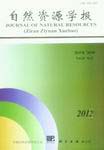Special Column:Celebration of the 70th Anniversary of IGSNRR, CAS
WANG Chuan-sheng, ZHU Shan-shan, SUN Gui-yan, FAN Jie
Slopes villages refer to villages locating on the slopes of mountains and hills, which are distributed extensively in mountain settlements and constitute an important type of the village settlements in China. The western mountainous areas, which are the main slope village distributed areas, have faced the resources and ecology bottleneck because the long time population growth pressure have made them in recent years the main areas of population movement, and frequent village migrations. With "the Main Function of the National Planning" implemented in the "Twelfth Five-Year Plan on National Economic and Social Development" period, the above regions will be faced the new opportunities and challenges. The spatial reorganization and the population migration in the slope village distributed mountainous areas will be also influenced. And finally the rural household livelihood and sustainable development in mountainous area will be affected. These two problems have exactly long puzzled the western rural development.
Accessing the villages space evolution and the peasant households, using the multi-time remote sensing images (TM, ETM, and Alos at 2.5 m resolution) and topographic maps of different scales (1:50000, 1:100000 and 1:250000), the disperse and concentrate characteristics of the two spatial evolutions types of the slope villages were analyzed by using the GIS spatial analysis tools. The concentration is the slope village households’movements from the slope lands down to the smooth lands under the environmental pressure and driven by most of the benefits. One concentration type is its position located on some bigger river valley plains and some main roads are caused by the spatial difference of the slope village’site conditions. Another nearby bigger markets and the advantageous traffic accesses are caused due to infrastructure reconstruction and market mechanism establishment in western mountainous areas. The dispersion is the slope village households’movements up to hills and developing hill slopes for seeking new lands owing to the population pressure. The main reasons for the slope village’s dispersion are the complex terrain, the limited land, the self-sufficient production pattern and the traditional life style of peasants. The rural household questionnaires were prepared in Guyuan and Zhaotong as typical area respectively in the Loess Plateau hilly area and the southwestern mountainous area. The rural livelihoods including the farmlands property, the incomes and the main life style and their changes in the process of the village space evolution and the movement of population are analyzed.
The conclusion believed that the spatial concentration and the completely moving out of the slope villages are beneficial to the mountainous area development. The spatial concentration of the slope villages may reduce pressures of resources and environment, enrich livelihood property of the rural households, enhance the income of the indigenous inhabitant, and, by advancing life types of the peasants, build a harmonious developing way between human and environment. However, from another angle, the lower bearing capacity of population and economic activities in the mountainous area limits the slope village’s expansion in scale. And more, owing to lack of the outer communication, the decentralization also may be the normal process of the slope villages’spatial evolution in mountainous area. At that time, the moderate scale household properties, the diversifying household livelihoods, the comfortable living environment, the slope villages’spatial system coordinated with environment, which should be concerned on sustainable development in the mountainous area.
